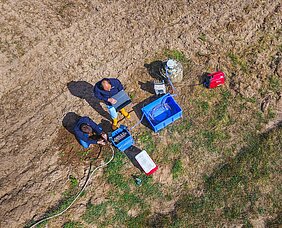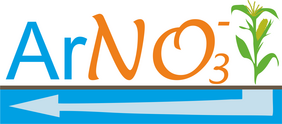The revision of nitrate comtaminated areas (so-called "Rote Gebiete") is currently the subject of debate. In some areas, farmers and water suppliers question the methods used to identify and mark out areas contaminated with nitrate, in which strict fertilizer regulations apply. The aim of the research project "ArNO" is to test and evaluate methods used to assess nitrate pollution in groundwater. The focus lies on the consideration of nitrate inputs masked by nitrate degradation.
The introduction of nitrate into groundwater, for example through leaching from agricultural land, has a negative impact on water quality and is a major problem for many water suppliers and ecosystems. As part of the implementation of the EU Nitrate Directive (91/676/EEC), the General Administrative Regulation on the designation of nitrate-contaminated areas (so-called "Rote Gebiete") was re-issued on August 10, 2022 (AVV Gebietsausweisung (AVV GeA), BAnz AT 16.08.2022 B2), which made it necessary to revise the previously designated areas. The designation of nitrate-contaminated areas must now be based on the nitrate concentrations measured at defined measuring points (immission-based designation). In this context, it is also required to check whether denitrifying conditions exist in the groundwater, as these enable the degradation of nitrate. If nitrate degradation takes place, the nitrate concentration measured in the groundwater does not allow conclusions to be drawn about the initial nitrate input. This is problematic as the nitrate degradation potential is finite. If denitrifying conditions are present in the groundwater, it is therefore necessary to determine historical or masked nitrate inputs via a "denitrification value".
In the scope of the "Groundwater-project ArNO: Nitrate contamination of catchment areas - Suitability of used groundwater measuring points for determining nitrate contamination, with consideration of historical nitrate inputs", various methods used for the assessment of nitrate contamination in groundwater are tested and evaluated. For example, minimum requirements for the construction of groundwater measuring points with regard to nitrate are determined. This is crucial in order to ensure that a groundwater measuring point is suited be included in the monitoring network. In addition, geostatistical methods for the spatial interpolation of nitrate pollution in areas are compared and evaluated. To do so, both theoretical considerations and suitable real data on nitrate concentrations from groundwater monitoring programs are applied. The requirements for sampling under different regional conditions are determined based on groundwater investigations at selected groundwater measuring points in three different federal states. Analysis are perfomed using the nitrogen-argon method which allows the "denitrification value" to be determined. In addition, the masked, historical nitrate input is studied and the reproducibility and temporal variability of the denitrification value are investigated. Furthermore it is examined, whether the validity and applicability of the nitrogen-argon method can be increased or supplemented by including the analysis of organic trace substances, such as trifluoroacetate (TFA), as markers for agricultural inputs.
The project results will be made available on this website through various information products, such as a fact sheet on minimum requirements for groundwater measuring points for nitrate sampling, a decision aid for selecting the interpolation method and a fact sheet on sampling requirements. In addition, the project results will be presented to authorities and water suppliers during two workshops.
The project consortium consists of the following associated partners: badenovaNETZE GmbH, Stadtwerke Bruchsal GmbH, Landesamt für Umwelt Brandenburg, Landesamt für Umwelt Rheinland-Pfalz, Landesanstalt für Umwelt Baden-Württemberg, Landesamt für Umwelt, Naturschutz und Geologie Mecklenburg-Vorpommern.
The Federal Ministry of Research, Technology and Space (BMFTR) is funding the “Groundwater-Project ArNO” as part of the federal research program on water “Wasser: N”. Wasser: N contributes to the BMFTR “Research for Sustainability’ (FONA) Strategy.

![[Translate to English:] Prüfstelle-Produktprüfung_Teststand Test centre and product testing](/fileadmin/_processed_/0/9/csm_TZW-Karlsruhe_Pruefung_Geraete-Teststand_377188946c.jpg)




























